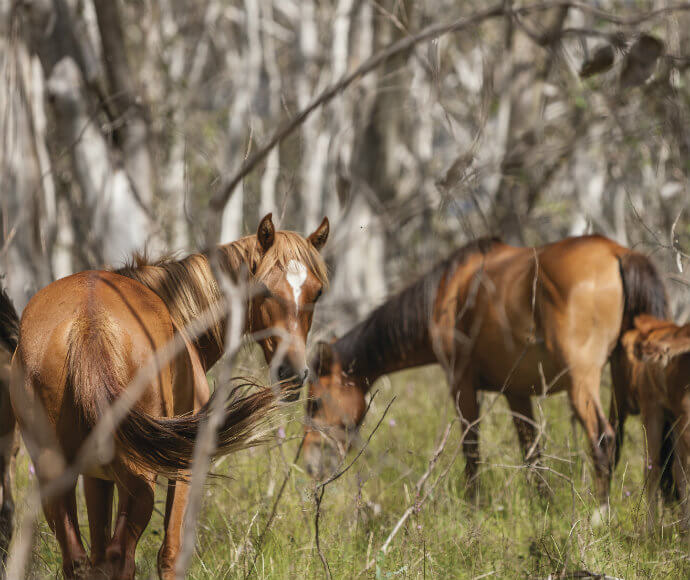If you have ever considered taking home a Kosciuszko wild horse, this is your chance. The National Parks and Wildlife Service (NPWS) is offering horses removed from the Cooleman, Kiandra and Nungar areas of the park to the public.
Since 2002, NPWS has rehomed almost 1,000 horses from Kosciuszko National Park. With your help, we can rehome more.

Brumbies, wild horses, walk among the snow gums in Kosciuszko National Park.
Rehoming is an important commitment
NPWS is seeking good, long-term homes for horses removed from the park.
Before applying to NPWS, please take the time to consider whether you have the necessary skills, facilities and resources (both money and time) to adequately care for and train a wild horse. These animals have received no training, handling or veterinary care and are unfamiliar with the human-built environment.
Current control program
The post-bushfire control of wild horses in Kosciusko National Park is underway. Horses are currently being removed using passive trapping. Rehoming remains the priority for horses removed from the park. However, where homes are unable to be identified, horses will be sent to a knackery.
So far, NPWS has received a good response to rehoming, with 21 applications approved to rehome up to 282 horses.
Control program outcomes* to 1 October 2020:
- Program dates: 23 July to 1 October 2020
- Number of trapping days: 19
- Horses removed: 193
- Horses rehomed: 178
- Horses sent to knackery: 14
- Total trapping-related deaths: 1
- Horses released: 46
*Notes:
- The control program is ongoing and likely to continue for the remainder of the year.
- The weather has reduced the number of trapping days.
- Horses are released if they do not meet NPWS current criteria for removal due to transport limitations and this includes heavily pregnant mares and mares with very young foals.
- One mare died while being held in the trap yards due to a suspected head injury. No other horses were injured. Horse deaths in trap yards are a very rare occurrence in the history of the trapping and removal program.
Horses are offered based on rehomer preferences
Most rehomers have specified preferences for the types of horses they are willing to receive. As such, NPWS's ability to rehome horses also depends on the type of horses requested, not just the number requested.
If an approved application has requested certain types of horses, and these become available, then NPWS will always aim to make sure those horses are offered to the relevant rehomers in the first instance. NPWS will only send horses to the knackery if it is unable to identify homes for those horses. For this reason, approved rehomers must advise NPWS in writing as soon as possible if they wish to change their preferences for the types of horses requested.
Support for rehoming
NPWS is actively promoting rehoming during the post-bushfire control program.
NPWS continues to demonstrate its commitment to rehoming by offering a financial contribution towards the first 400 kilometres of transport for rehomers. This assistance is in place while COVID-19 restrictions prevent private travel in some areas.
How to apply
Full details of the rehoming program, including the rehoming guidelines and application form, continue to be available. Stakeholders like you will also continue to receive rehoming updates.
Horses are expected to be available for rehoming throughout the remainder of the year. Interested individual and groups will need to meet the guidelines and complete the application form to help ensure the horses find good homes.
You need to take a minimum of 5 horses if you would like to apply for horses from NPWS. However, for those people that would like to take home a smaller number, please contact the approved rehomers listed on our website. Let them know you are interested in rehoming a horse and find out what they have available.